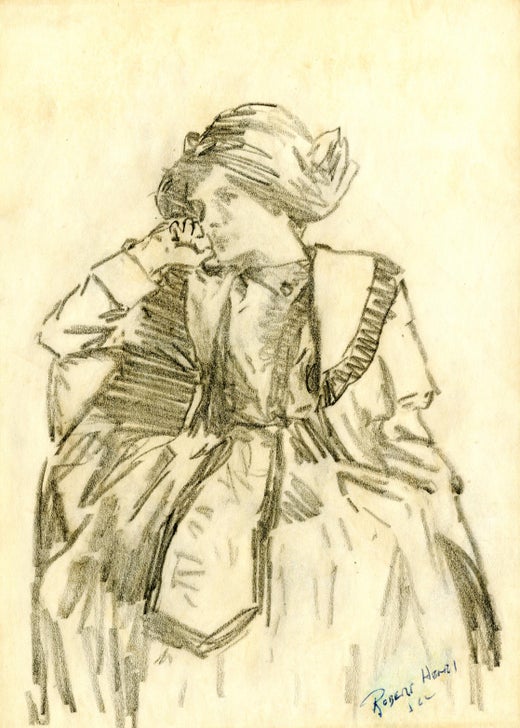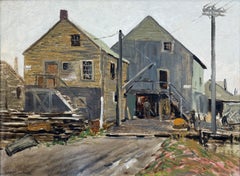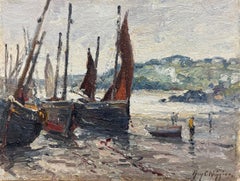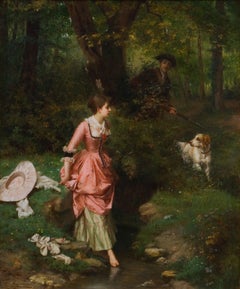Want more images or videos?
Request additional images or videos from the seller
1 of 8
Robert Henri"Haarlem Windmill, " Robert Henri, Dutch Rural Ashcan Scene, Netherlands1907
1907
$22,000List Price
About the Item
- Creator:Robert Henri (1865-1929, American)
- Creation Year:1907
- Dimensions:Height: 10 in (25.4 cm)Width: 11.5 in (29.21 cm)
- Medium:
- Movement & Style:
- Period:
- Condition:Excellent.
- Gallery Location:New York, NY
- Reference Number:1stDibs: LU184129923422
Robert Henri
Born Robert Henry Cozad, Robert shared a lineage with Mary Cassatt, making them cousins. Henri kept secret that relationship much as he did his birth name, in an effort to erase the reputation of a murder conviction against his father John Cozad. Robert's childhood reads like a Bret Harte short story. From card shark to real estate speculator, Henri's father moved the family from Cincinnati to Nebraska in a series of speculative land development projects. A disgruntled employee attacked Robert's father, and in self-defense his gun fired, killing the attacker. The murder conviction, later pardoned, led to the family's fleeing to Colorado, and assuming new identities. Robert Henri was sent to boarding school in New York, where he showed talent in writing and theater, creative endeavors encouraged by his mother. He discounted his creativity, thinking "artists surprised their parents... by doing masterpieces in their infancy... and [he] was not of that class" (Perlman). Nevertheless, painting buildings his father acquired in Atlantic City and producing political cartoons and color sketches for a small "museum" in his father's store caught the attention of admirers who encouraged Robert's art. James Albert Cathcart persuaded Henri to study at his alma mater, the Pennsylvania Academy of Fine Arts, where Henri enrolled in 1886. Robert Henri’s strong connection to the Pennsylvania Academy of the Fine Arts began when he enrolled as a student in 1886. He entered the Academy eight months after Thomas Eakins had resigned. Despite Eakins’s absence, his strong influence on the curriculum at PAFA remained and it affected Henri profoundly. Eakins had instituted new educational policies at the Academy that were some of the most progressive in the country. Thomas Anshutz played an important role in Henri’s development as an artist. He upheld many of Eakins’s ideas and continued to build upon his teaching method; however, Anshutz was also open to change and cultivated individual artistic expression. A devoted teacher, he did not impose artistic formulas. Henri valued Anshutz’s criticism greatly, and determined to succeed as an artist, he worked tirelessly as his student. After studying for three years in Paris from 1888 to 1891, Henri returned to Philadelphia and the halls of the Academy. Steeped in Anshutz’s call for realism and plain painting without bravura, Henri challenged himself and the other artists he influenced to “paint what you feel . . . paint what is real to you.” And so began his lifelong pursuit of painting “life in the raw,” without what he deemed “academic artifice.” He promoted this credo to his many students and perhaps popularized it most in his sensational 1908 exhibition at Macbeth Gallery, where he and a group of artists, eventually called The Eight, mounted a show that was a direct affront to the National Academy of Design’s rejection of their work and the modernist spirit that shaped them as artists. Henri met four of the artists who made up The Eight, William Glackens, John Sloan, Everett Shinn, and George Luks, in Philadelphia, where they all took classes at PAFA.
About the Seller
5.0
Platinum Seller
Premium sellers with a 4.7+ rating and 24-hour response times
Established in 2022
1stDibs seller since 2022
122 sales on 1stDibs
Authenticity Guarantee
In the unlikely event there’s an issue with an item’s authenticity, contact us within 1 year for a full refund. DetailsMoney-Back Guarantee
If your item is not as described, is damaged in transit, or does not arrive, contact us within 7 days for a full refund. Details24-Hour Cancellation
You have a 24-hour grace period in which to reconsider your purchase, with no questions asked.Vetted Professional Sellers
Our world-class sellers must adhere to strict standards for service and quality, maintaining the integrity of our listings.Price-Match Guarantee
If you find that a seller listed the same item for a lower price elsewhere, we’ll match it.Trusted Global Delivery
Our best-in-class carrier network provides specialized shipping options worldwide, including custom delivery.You May Also Like
"After the Storm"
By John R. Grabach
Located in Lambertville, NJ
Signed LL
John Grabach was a highly regarded New Jersey artist, teacher and author of a classic text, How to Draw the Human Figure. He was born in Massachusetts, and with his widow...
Category
20th Century Ashcan School Figurative Paintings
Materials
Oil, Panel
Under the Hollow
By Alexander Oscar Levy
Located in Buffalo, NY
An important American modern landscape by Ashcan school artist Alexander O. Levy.
This painting was featured in the retrospective for the artist held at the Burchfield Penney Art Ce...
Category
1930s Ashcan School Landscape Paintings
Materials
Canvas, Oil
Forest Landscape
By George Luks
Located in New York, NY
Landscape by George Luks (1867-1933)
Oil on canvas
11 x 14 inches unframed (27.94 x 35.56 cm)
Signed lower left
Description:
George Luks was an American artist originally born in Pe...
Category
20th Century Ashcan School Landscape Paintings
Materials
Oil
“Kids Going Skating”
By John R. Grabach
Located in Lambertville, NJ
Jim’s of Lambertville is proud to offer this artwork.
Signed lower right.
Complemented by a hand carved and gilt frame.
John R. Grabach (1886 - 1981)
John Grabach w...
Category
20th Century Ashcan School Landscape Paintings
Materials
Oil, Board
Modernist Oil Painting the Shop Window NYC 1940s WPA era
By Maurice Becker
Located in Surfside, FL
the Shop Window New York City, 1940s
17.75X25 sight size.
Maurice Becker (1889–1975) was a radical political artist best known for his work in the 1910s and 1920s for such publica...
Category
Early 20th Century Ashcan School Landscape Paintings
Materials
Oil, Board
The Fishmonger 1940's New York Impasto Figurative Cityscape
By Dorothy Rossen Greenberg
Located in Soquel, CA
A vivid mid-century impasto figurative cityscape oil painting of New York during the 1940s by Dorothy Rossen Greenberg (American, 1915-2005). A Fishmonger plies his trade amidst a ha...
Category
1940s Ashcan School Figurative Paintings
Materials
Oil, Linen
$3,080 Sale Price
20% Off
H 17 in W 21.5 in D 1 in
Mal's (At Cliff Evan's Cabin)
Located in Salt Lake City, UT
Mal's (At Cliff Evan's Cabin), by Waldo Midgley. watercolor, 9 x 12 inches (Framed size: 18.5 x 21 inches), $1,500
Waldo Midgley (1888-1986) had a fruit...
Category
Mid-20th Century Ashcan School Landscape Drawings and Watercolors
Materials
Watercolor
Channel Chop
By Nicholas Berger
Located in Greenwich, CT
American, b. 1949
In his more than three decades as an artist, Nicholas Berger (b. 1949) has created an outstanding body of work that continues to evolve and excite viewers. Best kn...
Category
2010s American Realist Landscape Paintings
Materials
Oil, Panel
"Dog Tree" (2021), Original Lake Landscape, Watercolor Painting
By Hazel Z Weckbach
Located in Denver, CO
Kevin Weckbach's (US based) "Dog Tree" is an original, hand-made oil painting that depicts a large tree next to a lake.
Artist Statement:
"Subject matter to me is a vehicle for me t...
Category
2010s American Impressionist Landscape Paintings
Materials
Oil, Panel
Relic of a Sunken Day Brooklyn
By Tom Irizarry Studio
Located in Booklyn, NY
Painted on panel, this piece dates back to the 1990's when I created a collection of small panel paintings. Relic of a Sunken Day shows layers of oil glazes on aluminum on panel crea...
Category
2010s Abstract Paintings
Materials
Resin, Oil, Wood Panel, Pigment
More From This Seller
View All"Portland Harbor, Maine, " Alexander Bower, Snowy River Scene in Winter
By Alexander Bower
Located in New York, NY
Alexander Bower (1875 - 1952)
Portland Harbor, Maine, 1910
Oil on canvas
27 x 33 inches
Signed and dated lower right
An American Impressionist, Alexande Bower was born in New York, studied at The Pennsylvania Academy of Fine Art, and was living with his wife in Cliff Island, Maine by 1914. Despite his urban upbringing, the coast and the sea fascinated Bower. A large portion of his paintings are seascapes, particularly scenes depicting the coast of Cape Elizabeth...
Category
1910s Ashcan School Landscape Paintings
Materials
Canvas, Oil
$36,000 Sale Price
20% Off
"On the Wharf" Everett Warner, Marine Town Scene, American Impressionism
Located in New York, NY
Everett Warner
On the Wharf
Signed lower left
Oil on panel
15 x 20 inches
Provenance
Cooley Gallery, Old Lyme, Connecticut
Everett Warner was born in...
Category
1930s American Impressionist Figurative Paintings
Materials
Oil, Panel
"Clearing after a Shower" Guy Wiggins, Impressionist Gloucester Schooners
By Guy Wiggins
Located in New York, NY
Guy Wiggins
Clearing after a Shower
Signed lower right, titled on verso
Oil on panel
12 x 16 inches
Guy Carleton Wiggins is best known for his impressionistic snow scenes of New Yo...
Category
1910s American Impressionist Figurative Paintings
Materials
Oil, Wood Panel
"Young Beauty Crossing Brook with Hunter, " Emile Pierre Metzmacher French Salon
Located in New York, NY
Émile-Pierre Metzmacher (French, 1815 - 1890)
A Young Beauty Crossing a Brook, A Hunter Beyond
Oil on panel
24 x 19 1/2 inches
Signed lower left
Provenance:
Christie's New York, Oct...
Category
Mid-19th Century Figurative Paintings
Materials
Oil, Wood Panel
"On the Beach, " Nicolai Cikovsky, American Impressionism, Landscape Seascape
By Nicolai Cikovsky
Located in New York, NY
Nicolai S. Cikovsky (1894 - 1984)
On the Beach
Oil on panel
15 1/4 x 20 inches
Signed lower right
Provenance:
ACA Galleries, New York
Category
Mid-20th Century American Impressionist Landscape Paintings
Materials
Oil, Panel
"MacMahan's Maine, " Howard Everett Giles, Figurative Landscape, Impressionism
Located in New York, NY
Howard Everett Giles (1876 - 1955)
MacMahan's Maine
Oil on canvas backed with board
30 x 30 inches
Signed lower right
Provenance:
Art Institute of Chicago
Christie's New York, December 8, 2011, Lot 2
Howard Giles spent most of his career in New York City, where he was an educator, magazine illustrator, and painter who espoused the theory of Dynamic Symmetry. He was born in Brooklyn, and as a young man worked in a New York railroad office. Financial support of a family friend allowed him to study at the Art Students League with H. Siddons Mowbray. In early 1910, he became an illustrator for Scribner's Magazine, and in 1912, on sketching assignment for Scribner's went to England. During World War I, he did illustration for Harper's Monthly Magazine, and many of his images were 'roaring twenties' genre and figure paintings.
In 1912, he began teaching life classes at the New York School of Fine and Applied Arts (later Parsons School of Design), and remained there until the late 1920s. During that time, he was also a part-time instructor at the Childs-Walker School in Boston, and accepted numerous invitations to lecture including at Carnegie Institute in Pittsburgh, Pennsylvania Academy of the Fine Arts, Detroit Institute of Arts and Wellesley College.
His initial painting style was Impressionism, but he grew increasingly interested in other scientific, aesthetic theories. He worked with Jay Hambridge from 1916 to 1919, applying Hambridge's theory of Dynamic Symmetry to his painting and his lecture topics. From 1922 to 1926, Giles also worked with and was influenced in his own painting by colorist theorist Denman Ross, who espoused a limited and related color palette. For many of his paintings, Giles used watercolor although he also painted in oil and pastels.
During the last years before his retirement when he moved to Woodstock...
Category
Early 20th Century American Impressionist Landscape Paintings
Materials
Oil, Panel
Recently Viewed
View AllMore Ways To Browse
Dutch Windmill
Richard Lee
Robert Holland
Hillier Parker
Holland Painting Of Boats
Hunting Scene Horse Hound
Idaho Landscape Painting
Impasto Painting Boat
Ireland Sketch
Irwin Whitaker
James Reynolds
Josep Maria Vayreda Canadell On Sale
Joshua Tree Painting
Jules Noel
Kansas Oil Painting
Kit Carson
La Montagne Painting
Landscape Painting By Collins



